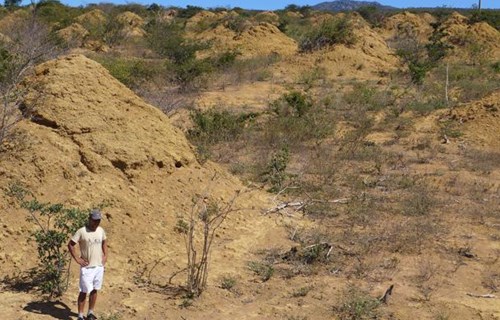研究人员近日在巴西东北部的森林里发现了大量数米高由白蚁建造的“金字塔”。它们有近4000年历史,且现在仍有白蚁在其中活动。

In the east of Brazil, mysterious cones of earth rise from the dry, hard-baked soil. Each of these mounds is about 30 feet wide at its base, and stands six to 13 feet tall. From the ground, with about 60 feet of overgrown land separating each mound from its neighbors, it’s hard to tell how many there are. But their true extent becomes dramatically clear from space.
在巴西东部,干燥、坚硬的地面上分布着好多神秘的锥状土堆,这些土堆底部宽约30英尺,高6至13英尺。从地面上看,相邻土堆之间距离大概有60英尺,其间杂草丛生,很难数清具体有多少个,但是从空中却能清楚的看到其真实范围。
Using satellite images, Roy Funch from the State University of Feira de Santana has estimated that there are about 200 million of these mounds. They’re arrayed in an uncannily regular honeycomb-like pattern. Together, they cover an area roughly the size of great Britain or Oregon, and they occupy as much space as the Great Pyramid of Giza 4,000 times over. And this colossal feat of engineering is, according to Funch, the work of the tiniest of engineers—a species of termite called Syntermes dirus, whose workers are barely half an inch long.
通过卫星图像,来自桑塔纳费拉州立大学的罗伊.芬奇估计,大约有2亿个这样的土堆。它们以一种不可思议的规则的蜂窝状排列。这些土堆加在一起,面积大约相当于英国或俄勒冈州,体积相当于4000多个吉萨大金字塔。根据芬奇的说法,这一巨大的工程壮举是最微小的工程人员的杰作—一种叫做Syntermes dirus的白蚁,而这种白蚁的工蚁只有半英寸长。
Termites are well known for creating elaborate nests, with vast networks of underground tunnels. Many species create skyscraping chimneys atop these lairs to ventilate the underground chambers, and in some African species, these mounds can tower 30 feet high. But the Brazilian mounds are neither chimneys nor nests. They’re with no internal structures. Nothing lives inside them.
白蚁以筑巢精细闻名,在它们的地下巢穴中有巨大的隧道网络。许多物种在其洞穴顶部都会建造高耸入云的烟囱来通风,在一些非洲物种中,这些土堆甚至可以高达30英尺。但是在巴西发现的这些土堆既不是烟囱也不是巢穴。这些土堆没有内部结构,里面什么也没有。
The local termites create extensive subterranean labyrinths of tunnels, and they eject whatever soil they don’t need on the surface. The process is slow and gradual, but the termites have been at it for millennia. They’re more like a geological force than an organism. Just as rivers or glaciers sculpt the landscape around them, so too have these tiny insects sculpted some 90,000 square miles of Brazil into a junkyard that’s visible from space.
白蚁在地下挖掘巨大的迷宫巢穴时,会把那些多余的泥土搬运到地面。这个过程循序渐进,白蚁们上千年一直在从事着这项活动。虽然是生命体的活动,但是这个过程看上去更像是一种地质力量,就像河流或冰川塑造了它们周围的景观一样,这些微小的昆虫也将巴西约9万平方英里的土地塑造成了从空中可见的垃圾场。







